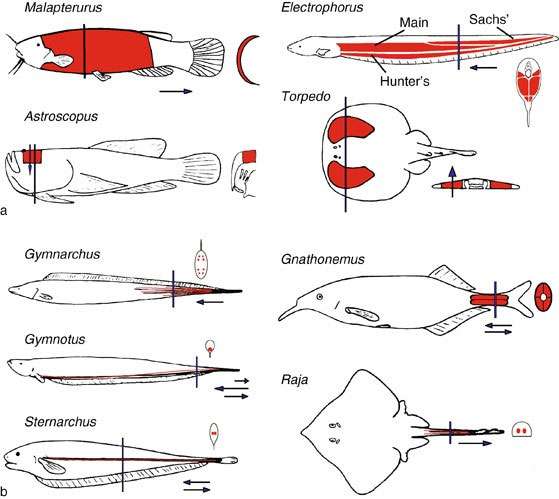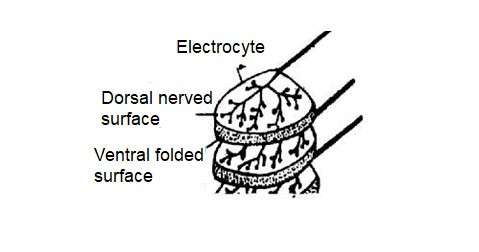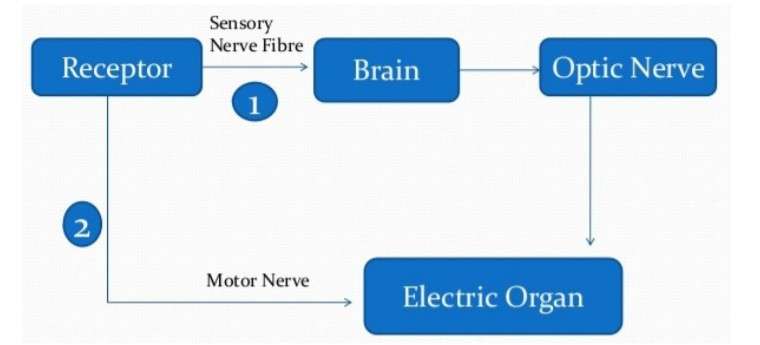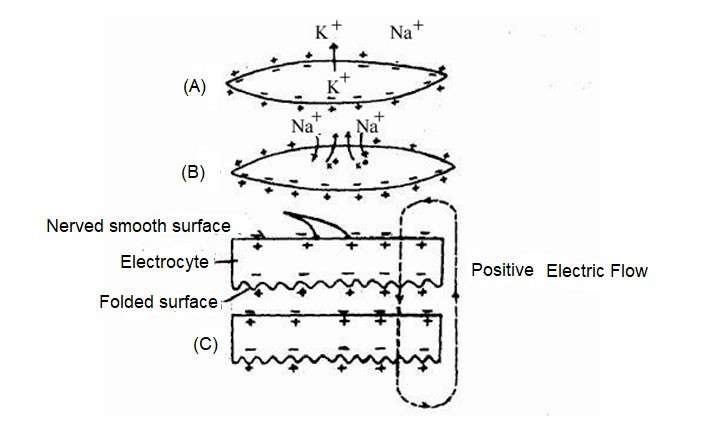Many fish have special organs that can generate electricity. Electrical organs in fishes are advanced and specialized structures that enable the carrier to generate, store, and release electricity. Only fish has the ability to generate this electricity in the animal kingdom. About 250 species of cartilaginous and bony fish can generate this electricity. This organ has been introduced in fish to meet certain needs. Cartilaginous fish, especially electric rays (Narcine timlei, N. brunea, Narke diptergia) and skates (Raja) have well-developed electric organs.
This organ exists in several species of bony fish, such as the Electrophorus electricus, which is found in the river of South America, and the Gymnarchus and Mormyrus, a catfish is found in the African river, and two star grazers, such as the American Astroscopus, the Mediterranean Uranoscopus, and other electric fish. Narcine timlei, N. brunnea, Narke dipterygia and Uranoscopus are also found in Bangladesh.
Table: Characteristics of the electric organs of electric fish
|
Group |
Species |
Characteristics |
|---|---|---|
|
Teleosts |
Mormyrus |
Lives in freshwater. Weak electrical organs exist. Emits electric pulses of different frequencies. |
|
Teleosts |
Gymnarchus |
Lives in freshwater. Weak electrical organs exist. The electric vibration rate is fixed, the frequency can be turned off. |
|
Teleosts |
Electrophorus electricus |
Lives in freshwater. Weak and strong electrical organs exist. Emits varying degrees of electrical vibrations. |
|
Teleosts |
Gymnotus |
Lives in freshwater. Weak electrical organs. Emits electric pulses of constant frequency. |
|
Teleosts |
Malapterus |
Lives in freshwater. Strong electrical organs exist. Remains active irregularly. |
|
Teleosts |
Star grazer |
Marine. Strong electrical organs exist. Remains active irregularly. |
|
Elasmobranchii |
Rays |
Marine. Weak electrical organs exist. Remains active irregularly. |
|
Elasmobranchii |
Skates |
Marine. Strong and weak electrical organs exist. Remains active irregularly. |
Origin of Electric Organs in Different Fish: In skates (Raja), Electrophorus electricus and Mormyrids (Gymnarchus and Mormyrus) etc., the tail muscles of fish are transformed to form electric organs. This electric organ is formed by transforming the bronchial muscles adjacent to the gill arch in the Narke (= Torpedo), the body muscle in the catfish (Malapterus) and the eye muscle in the Stargrazer (Astroscopus).
Position of electrical organs in different fish: Different positions of electric organs are observed in different fish. In Narke, it is located on both sides of the head along the front edge of the gills and thoracic fins and is connected to the brain through nerves. In electric eels such as Electrophorus, Gymnotus and Sternarchus, it is located laterally from the stem to the end of the tail. In Raja, Gnathonemus and Gymnarchus it is confined to the tail region only and is nerved from the spinal cord. In the African catfish (Melapterus), it is located on the skin and muscles along the whole body. In Astroscopus, it is located behind the both eyes.

Figure-Electric organs in Fish: Color part indicates the presence of electromagnetic organs and the direction of electric current.
Structure of the Electric Organs: Differences in the size, shape and position of the electric organs can be noticed in different fish. An ideal electric organ consists of a large number of disc-shaped cells called electroplates or electrocytes. These cells are embedded in the jelly-like extracellular matrix and form a chamber or elongated tube-shaped structure from being bound to each other by connective tissue. The jelly acquires a blood clot and attaches to one of the nerve endings in the electroplate. Each electroplate contains a polycyclic, transparent cytoplasm with synovial cells whose surface is tangled.
The electroplate is divided into outer, middle and inner parts. The outer part is nerved and it is nerved from the marginal border of nerve fibers of nervous system. The middle part is linear or long-stained and the inner part is higher folded to form numerous papillae-like structures which increase the surface for electric emissions. Each electroplate has large papillae at the smooth nerveless end of the nerve end. Electroplate cells are formed by mixing jelly-like material with uneven muscles. The structure of the electric organs of different fish is described below:

Image: Narcine’s stalked electrocyte
Electrical Organs in Rays and Skates: In Narcine, electric organs are more developed among the cartilaginous fish. It has a pair of electric organs at the head and the anterior end of the thoracic fins on each side. Each organ is a large flattened kidney-shaped structure consisting of whole muscles. Each organ consists of 48 vertical columns separated by fibrous tissue. Each column consists of numerous electroplates.
Numerous nerve endings produced by the 4 nerves (5th, 8th, 9th and 10th cranial nerves) can nerve this organ. These nerves originate from a nerve that originates from the electric lobe of the medulla oblongata and the fifth cranial nerve. The nerve endings of the electroplate receive the electrically negative charge and the other end the positive charge. In this species, electricity flows from the dorsal (positive) edge to the ventral (negative) edge. Narke can generate 30-50 volts of electricity. In other Rays, the electric organs are relatively small and located on the lateral side of the base of the tail. Narcine can generate 36 volts while Raja clavata can generate 14 volts electric current.
Electrical Organs in Electrophorus electricus: This fish is called electric eel and it is about 2.5 meters long like eel fish. They live in the muddy waters of the Amazon River and many rivers in South America. Among the fish, this fish has the highest development of electric organs. Here is a pair of electric organs located on each side of the body and weighing about half the weight of the body. One of the limbs is big and the other is small. Each organ consists of about 60 cells, each containing about 600 disc-shaped electroplates. About half of the body’s total tissue is engaged in producing electric current. It is nerved by nerves generated by the spinal cord. The charge of this electric current extends from the head to the tail. These fish can generate 270-550 volts of electricity on the land but drop to 260 volts due to short circuits in the water.
Electric Organ in Malapterus electricus: It is known as African catfish. It contains a strange type of electric organ that forms a thick covering over the skin and body and is divided into innumerable cells by the connective tissue. Each cell consists of numerous electroplates and its nerve endings are directed towards the tail. It can generate an electric current of 350-450 volts and its electric charge extends from the tail to the head.
Electrical Organs in Other Teleosts: In Uranoscopus and Astroscopus, the electric organs are small in size and are nerved by oculomotor and are made up of modified muscle tissue and are located in two oval cavities behind the eyes. It generates relatively mild electric current. In Steatogenys elegans, the electric organ is located in a cavity under the skin from the anterior edge of the lower jaw to the base edge of the thoracic fin. In Mormyrus, the tail muscle is transformed into a gentle electric current. Mormyrus kannume can generate mild electric fields of varying degrees. When the fish is stationary, the electric current flows less and it increases faster when it is moving. The cerebellum and acoustica lateralis regions of the brain are well developed to coordinate electric vibrations.
Electricity Flow of Different Species of Fish: Different species vary in polarity and power of current. The voltage is higher in the gaseous environment than in the aquatic environment. The following table gives the value of electricity production of some fish:
|
Name of Fish Species |
The amount of electric current |
|---|---|
|
Skates-Raja elevata |
4 volts |
|
Rays-Narcine |
37 volts |
|
Rays-Narke |
40 volts |
|
Star-grazer-Astrocopus |
50 volts |
|
Electric catfish-Malapterus |
350-450 volts |
|
Electric eel -Electrophorus |
370-550 volts |
Electric Generation Techniques in Different Fishes: The techniques for generating and storing electric current in electric organs are not well known. It is thought, however, that electric current is generated from the modified muscle of the last plate on the side of the nerve of the electrocyte. In the same way as normal nerve and muscle cells, the membrane is depolarized to generate tiny electrical potentials. The motor edges of the electroplate are more specialized in Narke and Dasyatis among the Elasmobranch.

In other bony fishes, on the other hand, it is transformed into muscle cells. It is thought that the electric current travels from a strong solution of sodium (Na +) and potassium (K +) ions to a mild solution. According to the ionic theory, in order to increase the penetration of sodium ions (Na +) in the membrane, the sodium (Na +) ion enters the cell first and then the potassium ion (K +) enters the cell when the penetration of the potassium (K +) ion in the membrane increases.
The control of the electric organs of most fish is accomplished through the central nervous system. Thus ions are transported to the cell membrane due to instantaneous or sudden voltage changes along the nerves of the cell. At rest, the two surfaces of the electroplate (neural and alveolar) have a positive charge on the outside and a negative charge on the inside. At rest, the penetration of potassium ions (K +) increases as compared to sodium ions (Na +), so that potassium (K +) ions penetrate the membrane faster than sodium ions (Na +). Potassium ions diffuse outward faster than sodium inward, resulting in an electric current of up to 100 mv and soon the stimulus moves to the nerve endings of the cell. The nerve endings become polarized due to the movement of sodium ions towards the inside of the membrane. For this reason, when the nerve endings are properly stimulated, the local inflow of sodium is generated, which increases the penetration of sodium ion membranes. These large inflows change the voltage of the membrane and provide the excitation to polarize the adjacent membrane. This excitation expands on the cell surface and depolarizes the nerve cell surface, resulting in the inflow of sodium ions into the smooth surface of the cell and the emission of potassium ions from the uneven surface. This transient electric current is called spike voltage. The electric current generated from each electroplate combines to form a larger external voltage which is above 600 mv in many fish.

Pathway of Neural Control of Electric organ in Fishes
Not all fish are the same in the direction of electrocution and electric current flow (e.g. in Narke the electric current goes from the dorsal side (+ ve) to the ventral side (-ve)). In Electrophorus and Gymnarchus, this flow goes from the tail to the edge of the head. In sternarchids, this electric current is generated from nerve fibers. Based on the intensity of electrical emissions, fish can be divided into two groups such as higher voltage and lower voltage. Narke, Electrophorus, Malapterus, Astroscopus and Gymnarchus generate large voltages of higher frequencies and are divided into a regular series of small vibrations and transmitted in the form of waves. These fish emit a continuous sinusoidal voltage between the two electric organs. In Narke, the interval between the two limbs was measured at 0.01 milliseconds. The response of fish waves is similar to that of reflex reactions. Many Mormyrids and Gymnotids fish produce tiny potentials of electricity. These fish produce very low frequency voltages that carry irregularly small vibrations between the two limbs for more than a second. Electrophorus is capable of generating intense or mild electric current as required. Intense electric current can generate up to 500-600 volts through large electric organs and up to 10 volts through small organs. Controlling and directional systems of electric organ exist in the brain.
With the help of microelectrodes in Electrophorus, it has been observed that the membrane potential is along the nerve side of the electroplate resulting in maximum electricity generation and the potential remains unchanged along the non-nerve side. When a microelectrode is inserted into an electroplate of the Electrophorus, a voltage of about 90 volts is generated on the resting nerve and non-nerve surface. During an electric current, the polarity of the posterior nerve surface changes and decreases to about 70 mv, and the voltage at the non-nerve surface remains unchanged. As a result, the total voltage difference on both sides of the cell is about 150 mv. The successive series of electroplates add voltage to create a strong electric current.

Figure: Power generation and emission techniques (a) voltage at rest; (b) voltage at excited state; (C) The inflow of Na + towards the nerve surface and the positive current due to the emission of K + towards the uneven surface
Function of Electric Organs
Electric organ is capable of generating electric current of different voltages. The work of this organ is mainly self-defense but it does many other things. Different fish vary in the structure, position and strength of their electric organs due to the variety of functions. The following are some of the functions of the electric organ:
1. Strong electric organs help to catch prey and protect it from enemy attacks.
2. In Malapterus and Narcine, this organ has more or less protective function.
3. The use of gentle electric currents has recently been reported to create an electric field around the Mormyrids. If an object tries to break this field, the fish responds to this change immediately. Mormyrids have poorly developed eyes and many of them live in muddy water. So this electric field acts as a warning method. However, it has not been discovered how the fish can detect the breakdown of the electric field. Probably because of their large cerebellum and dorsal fins, special cells are thought to be at work.
4. The electric current helps the fish to determine the direction of movement in the dark. It depends on the type of change in the electric current around the fish. For this purpose the lateral line system can detect the flow of electricity.
5. Another function of the electric current is to protect the boundaries of the fish habitat. In the case of some species of Mormyrids, the electric current increases when a fish of the same species comes in contact with another fish.
6. This organ is used to identify the species or sex. These electric signals vary between the two species. If the sensory organs of the fish are able to detect the pattern of electric current, it helps to identify and locate another member of the same species in the dark.
Fish with electric organs are protected from their own electric current and from each other from the electric reservoir (flow). Probably they have high insulation in the nervous system. Electrophorus’s spinal cord and swimming muscle are in a layer of thick fat. Their nerves and muscles can withstand abnormally high levels of excitation.
